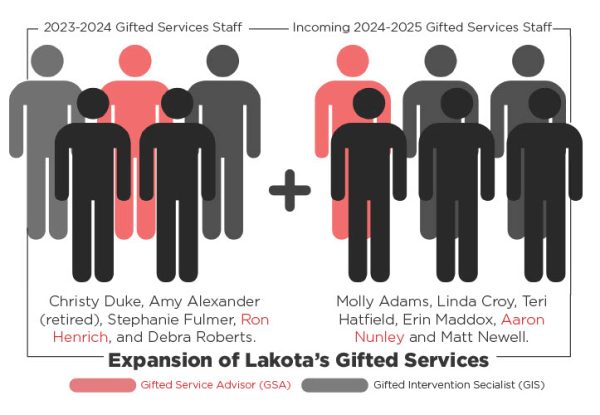Current East senior Hailey Lowe recalls the days when she was in sixth grade at VanGorden Elementary. After the second bell rang she would leave her sixth grade hall and report to her gifted math class in the wing adjacent.
“Mrs. Croy’s class was a lot more engaging than any other class that I’ve been in. She always had puzzles and other enrichment activities for us to solve in class,” Lowe told Spark.
Lakota consistently reports about their gifted service program which recently underwent expansion.
In early March of this year, Interim Superintendent Dr. Elizabeth Lolli sent out a Lakota Gifted Services Update. The update outlined the addition of four additional Gifted Intervention Specialists (GIS) and one additional Gifted Support Advisor (GSA), totaling five added staff members to the Gifted Services team.
The previous Gifted Services team consisted of Christy Duke, Stephanie Fulmer, Debbie Roberts, and Ron Henrich. The new GIS’s who will join the previous staff are Erin Maddox, Teri Hatfield, Linda Croy, Molly Adams, and Matt Newell. Aaron Nunley will join as a GSA.
“Four years ago the gifted service team was cut in half,” said director of Gifted Services Lauren Webb. “This expansion is a return to the number of gifted specialists Lakota had originally.”
In his time at Lakota, Henrich has been the only GSA for grades 7-12. Adding a second GSA is a return to what Lakota previously had.
“I have done this role for the past five years for all eight buildings, but having a second person will help us go deeper and broader than we have in previous years,” Henrich told Spark.
Henrich will be joined by Aaron Nunley for the 2024-25 school year. Nunley will be assigned as the GSA for East grades 7-12 and Henrich will be a GSA for West grades 7-12. This split will allow greater reach to more students as opposed to one GSA for the whole district.
“The advantage of being assigned to four buildings instead of eight allows for both Aaron and I to go deeper with the students on our caseload,” said Henrich. “We will both be at our respective high school buildings a minimum of one day per week as opposed to what we’ve done in the past where I was only present one day a month at the freshman and main campus.”
Another new gifted service program employee is thankful for the expansion and is hopeful that it will allow the district to grow.
“Our district’s gifted services model has gone through a lot of challenges and changes over the years which makes it exciting to see that the need of our gifted students is being recognized and supported,” new GIS at Cherokee Elementary Erin Maddox told Spark.
According to Webb, the primary change for this year is the amount of students that the program is able to reach.
“Previously, the GIS would push into ELA and Math Plus classrooms, but not as frequently,” said Webb. “Before, each GIS had to support two elementary buildings so they had very little time to push into classrooms in grades three through six. The model of support is the same this year, but with a major time improvement.”
When switching to this new model three years ago, Lakota saw an increase in Gifted Report Card Performance Index: 2021-22 with a 94%, 2022-23 with a 96.3%, and 97% in the 2023-24 school year.
Despite the program’s positive performance, Lakota’s community conversations suggested the program be reviewed to improve in order to help more students. Dr. Lolli’s update mentioned that she was following up on the community conversation the district held in the fall about gifted services in Lakota.
“Our team has been working diligently to review how services are currently offered to both identified gifted and accelerated students, and how the program can be improved,” said Lolli.
In a video titled “Lakota’s Community Conversations,” published on May 28, 2024, Lakota Local School Board vice president Kelly Casper said that the board truly does take community conversation feedback and uses it to make change and do something with it.
Lakota’s implementation of community conversations has received only positive feedback so far and has helped re-evaluate aspects of the district based on parent and community member feedback.
“I think [the gifted services expansion] is a smart and sound investment for a number of reasons,” new GIS at Woodland Elementary Matt Newell told Spark. “At the Elementary level, having more teachers in the classroom focusing on specific groups helps not only the classroom teacher but the students as well.”
Prior to Newell’s new role as a GIS, he was located at East Main Campus as a social studies teacher and department head.
“I have been in the district long enough to see the long-term benefits (and costs when we remove them) of programs like this,” said Newell. “Students who have received targeted gifted services throughout their K-8 education in particular, come into high school with better social skills, and more mental toughness. When those services are diminished or cut entirely, gifted students, like all students, struggle when content and workload eclipse their natural ability. And this happens to all kids. It just might be different ages depending on their gifts.”
Maddox also agrees that the expansion in resources will help the district’s performance.
“Like all specialized instruction, when we have the resources and opportunities to serve students at the younger ages, the better equipped they will be as they move through their education into the upper grades and beyond,” said Maddox.







































































































